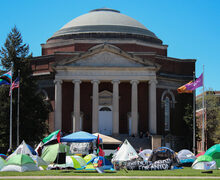Student Association : Administrator clarifies bill specifications
UPDATED: Oct. 19, 2011, 4:50 a.m.
Editor’s note: Tuesday’s coverage of the most recent Student Association meeting misstated information regarding the details of the Designation of Surplus Funding bill. The following article is intended to clarify any remaining ambiguity.
Following much discussion at Monday night’s Student Association meeting, the Designation of Surplus Funding bill was passed with a 45-10 vote, allocating $1,427,195 located in the Student Activity Fee account to University Union and the general fund.
UU was awarded $1,005,172. From this, $505,172 was allocated immediately to UU for an event, said Neal Casey, SA president. UU will receive the remaining $500,000 depending on the success of large-scale events between spring 2012 and fall 2013. If revenue generation is less than $250,000, funds will not be released; if revenue is between $250,000 and $499,999.99, UU will receive $250,000; and if revenue reaches $500,000 or more, $500,000 will be released.
The remaining $422,023 will go toward special programming in installments of $42,202.30 per semester during the next 10 semesters and will be designated to all student organizations through the normal SA budget process.
The accumulation of $1.4 million came from unused money collected from the student activity fee throughout the past few years, said Thomas Wolfe, senior vice president and dean of student affairs. The Division of Student Affairs approached SA about the extra funds in the spring, Wolfe said.
Every year, the SA Finance Board allocates the total student activity fee the anticipated student enrollment multiplied by the student activity fee to student organizations for special programming. When the fiscal year ends June 30, any unused money is carried over as additional available funds, Wolfe said.
After seeing an accumulation of $1.4 million in SA’s budget, DSA immediately began meeting with Casey and Jeff Rickert, SA comptroller. DSA encouraged SA to spend the money, Wolfe said.
‘We wanted to help them understand what’s going on with their account and to discuss the evolution of these funds and to encourage SA to use the funds,’ Wolfe said.
DSA did not give the $1.4 million to SA, and it was not placed in a separate account, Wolfe said. It represents the unused funds following the allocation process in April, he said.
Casey confirmed the source of the $1.4 million came from excess funds collected from the student activity fee, but declined to comment further.
Wolfe said he has never seen a surplus this large in SA’s budget before.
‘This has never happened before. We just discovered it,’ Wolfe said. ‘Sometimes carryovers can be small, sometimes they can be larger.’
SA distributes funds to student groups in April, two months before the fiscal year ends. SA must rely on estimates of student enrollment multiplied by the student fee. This makes it difficult to predict the available carryover funds, which is based on the amount of money SA does not allocate during the academic year.
‘There’s no secrets here at all,’ Wolfe said. ‘It’s in their account. It’s in their line item. There was no special account.’
Published on October 18, 2011 at 12:00 pm
Contact Laurence: [email protected] | @lgleveille




